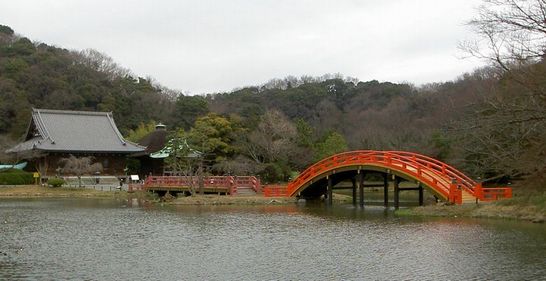Here's the text.
Shomei-ji Temple
Last Updated August 22, 2018
Nationally designated historic site "Shomeiji Temple"

[Summary]
◇Position: 212-1, Kanazawacho, Kanazawa-ku, Yokohama-shi and others
◇History of designated historic sites
【1】 October 12, 1922 (1922) Area 63,956 square meters
Name: "Sona-ji Temple, Kanazawa's grave and a generation tower for less than the Kaizan Triennale"
Reason: The buildings at that time were all decades, but the earthworks, culverts, culverts, garden ponds, etc. remain, and the traces of the Ritsumune temple boundary in Japan are one of the best preserved ones. In addition, the Kanazawa clan and the Olympic tower or treasure enclosure towers of less than the actual Kanazawa clan and the Olympic towers or treasure enclosing towers of less than the Kaizan judge are enough to see the tomb system at that time.
【2】 January 31, 1972 (1972) Area 91,289 square meters
Name: "Shomeiji Temple Precinct" (change)
Reason: The designation at the time of 1922 was to specify the range of clean area according to the 1323 (1323) "Shomeiji Ezunamiki" (Shomeiji Kura, Important Cultural Property). The original precincts are wider than this, and the surrounding mountain area and the pagoda area from Somon to Niomon were additionally designated, and the name was changed to Shomeiji precinct.
◇Designation of management organization
December 23, 1923 Kanazawa-mura, Kuraki-gun, Kanagawa Prefecture
October 1, 1936 (1936) Yokohama City (Kin Sawamura transferred to Yokohama City)
(1950) August 29, 1950 Yokohama City (continuation designation under the new law)
[Explanation]
Shomei-ji Temple is a temple of Kintakusan. Shingon Ritsu sect, Betsushi Motoyama. It is a bodhi temple of Kanazawa Hojo. The year of Shomei-ji Temple is not clear, but it is said that Hojo Sane Toki (1224-1276) developed from the Jibutsudo, which enshrines Amida Sanson in the residence of Rokuuraso. In fact, there is a record that he received a ritual of worship at the Jibutsudo in 1258 (1258), and a Shomei-ji Temple was built around 1259 (1259). In fact, he was a grandson of Yoshitoki Hojo, the second generation of the Kamakura Shogunate, and has served as a heavy job in the Shogunate, such as an appraiser and a evaluator, and politically supported the Hojo Tokushu sect. He moved from Kamakura to Rokuura and made the foundation for Kanazawabunko. In fact, he relied on the Eison of Nara Saidaiji Temple, changed Shomei-ji Temple from the Nenbutsu sect to Shingon Ritsu sect, and welcomed Shinkai Shonin (1232-1304) of Yakushi-ji Temple in Shimonokuni Yakushi-ji Temple. Was. Akitoki (1248-1301) donated land inside and outside the temple, erected the main statue of Maitreya Bodhisattva (important cultural property), and Sadaaki Sadaaki Sada (1278-1333) rebuilt the cathedral and worked to expand and develop the temple. In 1323 (1323) "Shomei-ji Illustration" surrounds the central garden pond and has Shichido Garan such as Kondo, Auditorium, bell tower, Niomon, and conveys the magnificent view of the temple at the time. In particular, the form from the southern Niomon gate in the south to the east and west, crossing the anti-bashi, Nakajima and Taira Bridge to Kondo is considered valuable as the last example of the Jodo-style garden, which was actively built since the middle of Heian.
After the death of Hojo in 1333, he was protected by the powers of Emperor Godaigo, Kokata Kamakura, Hideyoshi Toyotomi, and Ieyasu Tokugawa, but the luck of the temple did not recover and declined significantly in the Edo period .
Excavations and preservation and maintenance projects of Shomeiji Garden and Enike have been carried out for 10 years since 1978 (1978), and Taira Bridge was restored in 1985 and the Sobashi Bridge was restored in 61 based on the "Shomeiji Illustration". The garden was restored over the following year. However, since the bridge deteriorated and decayed due to the subsequent wind and rain, the Taira Bridge was replaced in 2007 and the rebellion was carried out in FY2008.
[Access] ※There is no parking lot at Shomei-ji Temple, so please use the following public transportation.
・About 15 minutes on foot from Keikyu Kanazawabunko Station, East Exit, or take a bus bound for Shibamachi.
・About 15 minutes walk from Umi no Koen Shibaguchi Station on the Kanazawa Seaside Line.
For inquiries to this page
Board of Education Secretariat General Affairs Department Lifelong Learning Cultural Properties Division
Phone: 045-671-3282
Phone: 045-671-3282
Fax: 045-224-5863
Email address: ky-syobun@city.yokohama.jp
Page ID: 129-798-666







